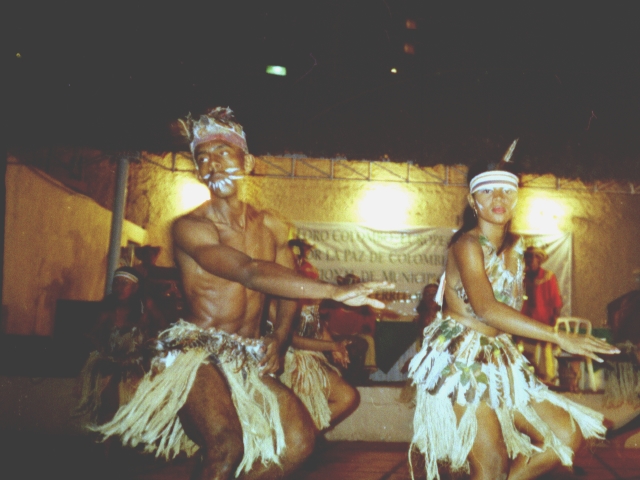
Photo Credit: Professor Thomas Flores
1. Background.
The School for Conflict Analysis and Resolution [S-CAR] has had an interest in local peacemaking and peacebuilding since the early 1990's. Much of the work has been carried out through the "Zones of Peace" Working Group [2001- 2011], which was one of a number of continuing S-CAR "Working" Groups. These consist of students and faculty from many countries and backgrounds who shared a common interest in particular conflict torn countries or in some aspect of conflict prevention, mitigation, resolution or transformation.
The School's Local Zones of Peace (ZoPs) project was formally established in September 2001. Led by Dr. Christopher Mitchell, the ZoPs team included faculty members Drs. Wallace Warfield and Kevin Avruch and doctoral students from a variety of countries (Colombia, Peru, India, China, the Philippines, Ecuador, Haiti and Japan) with varied and often direct personal experience in civil conflicts and peace building efforts. The ZoPs Group has focused on local peacemaking and peacebuilding, and especially on local people's efforts to estabish some kind of peaceful area or region which can serve as a sanctuary - an 'island of peace' - from the surrounding violence that arises from civil wars, ethnic conflicts and secessionist movements.
(See under "ZoPs Group Biographies" for details of members who made up the Group.)
2. History and Activities.
S-CAR's original interest in local zones of peace stems from a field visit made by faculty and doctoral candidates to Armenia in 1993. At that time, a local zone of non-violence was being established (with difficulty) along the new international border with neighbouring Azerbaijan and this sparked off interest in how such zones could contribute to peace building during intractable civil conflict. This led to the then Institute for Conflict Analysis and Resolution organising a conference in April 1996 on the theme "Local Zones of Peace in Civil Strife". The participants included academics interested in conflict resolution and practitioners who had experience in running local zones of peace. One result of this conference was a special issue of Peace Review (Vol. 9 No. 2 June 1997) on "Zones of Peace", edited by Dr. Christopher Mitchell and Dr. Susan Allen-Nan. This issue included contributions from a wide variety of practitioners, academics, ICAR faculty members and students.
A second project came from an interest in furthering understanding of local peaceful zones but is also an effort to help the peace building efforts of local communities in Colombia - an area on which the Institute focused in the late 1990s. Through this project we hoped to develop a better understanding of the strategies that led to the successful creation, maintenance and promotion of areas declared or designated as peace territories. The research was initially undertaken in association with the Bogota based civil society organization, REDPAZ, which had established its own project to support “100 Municipios de Paz” throughout Colombia. The project involved visits and in-depth interviews with local communities in four peace communities and four associations of local zones of peace in different regions of Colombia, field work which was supported by a grant from the United States Institute of Peace. In addition, the project involved continuing studies of local ZoPs in other countries torn by civil war including the Philippines, Indonesia, Peru, El Salvador and Sri Lanka.
Subsequent projects included a further exploration of a number of peace communities in Colombia, particularly those that were affected by President AlvaroUribe’s strategy of “democratic security”; a study of peaceable borderlands between neighbouring countries; and the role of women and of religious leaders in the establishing of durable peace communities.
One result of this work has been the publication of a collection of case studies of peace zones and other sanctuaries by Kumarian Press under the title of “Zones of Peace”, edited by Landon Hancock and Christopher Mitchell [Bloomfield, CT.; Kumarian Press; 2007]. Later a second edited volume, produced by the same editors, dealt with the relationship between national and local peacebuilding initiatives under the title of "Local Peacebuilding and National Peace" [London; Continuum; 2012]. For a full list of relevant pulications see ZoP Papers and Publications on this Web Site.
A further major output from S-CAR's ZoPs project is the current Web Site, which contains details of over 90 local peace communities and peace zones in various parts of the world. Initially this was planned to be available only in English but a later version will also be available in Spanish. The ZoPs web site willl be added to and updated periodically.
3. Outreach.
S-CAR facuty and students have made a large number of presentations about local peacebuilding to international conferences and at a variety of universities and colleges in North American, Europe, Latin America and Australasia, as well as to local NGO's and citizens' groups. S-CAR members of ICAR’s Local Zones of Peace team are more than willing to talk about their work and about local peacebuilding projects. Anyone interested in inviting a speaker on this topic should contact Dr. Christopher Mitchell at ICAR [e-mail [email protected]]
Zones Of Peace Group
School For Conflict Analysis and Resolution
George Mason University,
Arlington Virginia 22201
USA
ESPANOL
Grupo Zonas de Paz
Institudo de Analisis y Resolucion de los Conflictos
George Mason Univesity
Arlington , Virginia 22201
Estados Unidos
Local Peace-building Working Group
Dr. Christopher Mitchell has reconstituted the Zones of Peace Working Group under under a new title and with a broader focus. For more information, read the letter from Dr. Mitchell and check out the links below.
Newsletter Article: Analyzing Civil War and Local Peacebuilding at S-CAR
Students may request to join the group on the S-CAR Network


